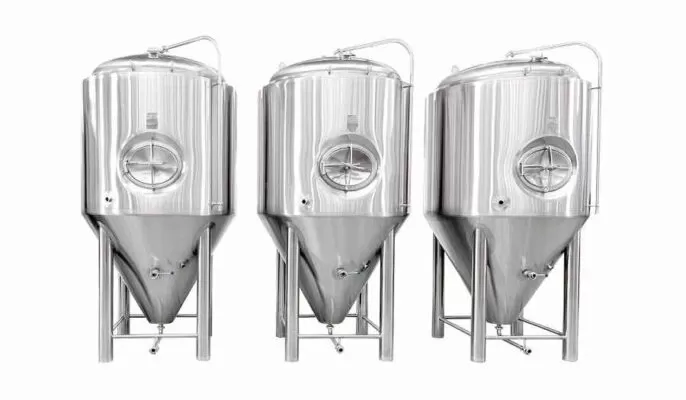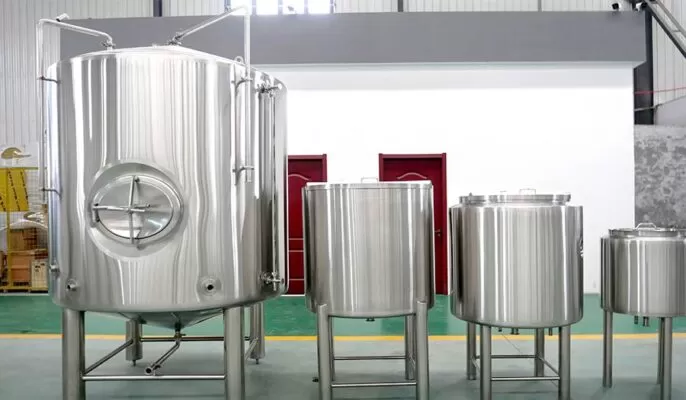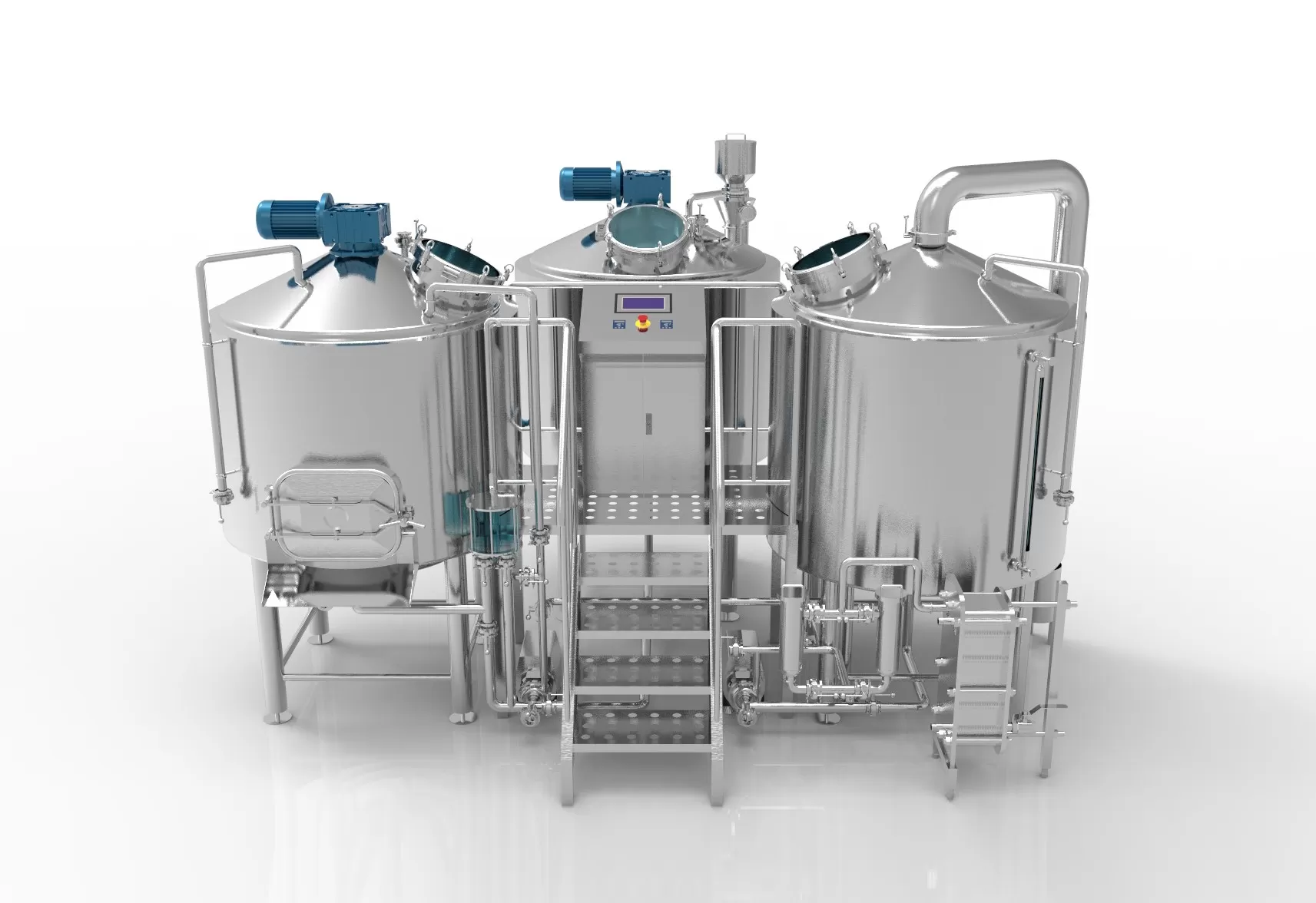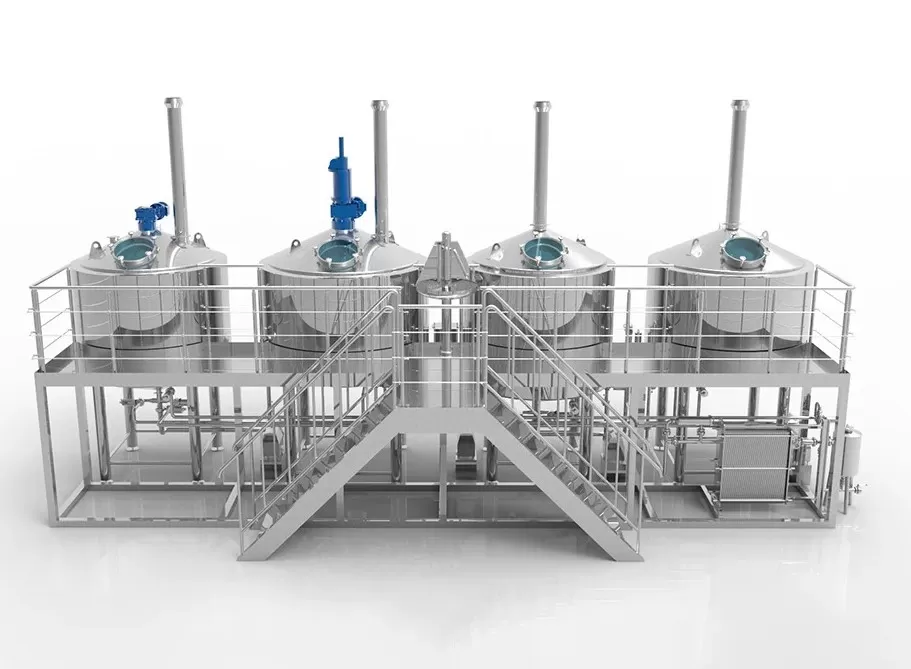Homebrewing beer as a hobby is fun and rewarding, but stepping up to commercial scale brewing is a whole new ballgame. Commercial beer production requires heavy-duty, high-volume equipment that can crank out top quality brews batch after batch. This guide will provide an overview of the essential commercial brewing gear and facilities needed to go pro.
An Overview of Commercial Beer Brewing
Commercial beer brewing involves producing beer on a large scale for sale and distribution, requiring specialized high-capacity equipment. Here’s a quick look at what’s needed:
Brewhouse – The brewing heart of the operation, including the mash tun, lauter tun, brew kettle, whirlpool, etc.
Fermentation Tanks – These hold the fermenting beer during the weeks-long fermentation and conditioning process.
Serving Tanks – Finished beer is stored here until ready for packaging or draft dispensing.
Kegging/Canning/Bottling – Equipment to package the beer for distribution and sale.
Ingredients & Supplies – Bulk volumes of malt, hops, yeast plus additives, sanitizers, cleaning chemicals.
Utilities – Access to electricity, water, gas, drainage, ventilation and climate control systems.
Quality Control – Lab equipment for testing ingredients, wort, and finished beer.
Safety Gear – Protective clothing, respirators, safety controls on machinery.
Maintenance & Cleaning – Keeping all equipment in working order and brewery plant clean and sanitized.
Let’s look at these critical components in detail:
The Brewhouse – Where Beer is Made
The brewhouse contains all the equipment needed to produce wort – the fermentable sugar liquid that yeast converts into beer. Here are the essential elements:
Milling Equipment
Malt Mill – Crack malt kernels open to extract fermentables during mashing. Two-roller model and six-roller model are common.
Malt Hopper – Holds malt before milling. Should be weatherproof and keep malt dry.
Screens – Remove hull debris from cracked malt.
Conveyors – Transfer malt to mashtun. Bucket, screw and belt conveyors are used.
Mashing Equipment
Mash Tun – Cooks milled malt at temperatures to convert starches to fermentable sugars. Insulated stainless steel is typical.
Mash Mixer – Mixes mash to ensure even temperature and conversion.
Mash Filters – Separate sweet wort from spent malt grains. Plate-and-frame filter is most popular.
Lautering Equipment
Lauter Tun – Tank where sweet wort is separated from grains.
Grant – Collects clear wort from lauter tun before boiling.
Brewing Kettle
Brew Kettle – Boils wort with hops to impart bitterness, flavor and aroma. Minimum size of 10 barrel (BBL) up to 200 BBL. Direct fire or steam heated. Constructed of stainless steel.
Whirlpool – Swirls hot wort to remove trub and hops. Can be part of brewkettle or separate tank.
Heat Exchanger – Cools boiled wort quickly before fermentation. Plated heat exchanger is common.
Pumps – Move liquids between vessels. Centrifugal and rotary lobe pumps used.
Piping – Food-grade stainless steel piping connects all brewhouse equipment.
Brewing Control Panel – Automated system controls timing and sequencing of brewing steps.
Proper sizing, configuration and quality of the brewhouse equipment are critical for achieving desired beer styles and production volumes.

Fermentation and Lagering Tanks
Once wort is produced in the brewhouse, it’s transferred to fermentation tanks to convert sugars into alcohol and CO2.
Fermentation Tanks
Cylindroconical fermenters – Stainless steel, double-walled and insulated. Sizes from 30 to 300 hectoliters typical. Have ports for removing yeast and trub.
Open fermenters – Shallow, open-top tanks used mainly for ales. Let aroma compounds escape.
Temperature control – Precise control over fermentation temperature is needed, via glycol jacket or heat exchanger.
Maturation and Lagering Tanks
Aging tanks – After initial fermentation, beer conditions here for weeks to months. Helps develop flavor.
Yeast storage tanks – Holds yeast slurry for re-pitching into next batch.
Brite tanks – Beer is carbonated and clarified here before packaging.
Properly sized fermentation and lagering tanks ensure you can meet production targets and manage inventory.
Beer Serving Tanks and Draft Systems
Once conditioned and carbonated, beer needs to be safely stored until packaging or tapping for draft service.
Serving Tanks
Serving tanks – Insulated unit tanks hold finished beer ready for kegging, bottling or canning. Direct draw is an option.
Beer glycol chillers – Keep beer cold as it’s transferred from serving tank to draft taps, typically at 35°F.
Draft Dispensing Equipment
Draft towers – Display draft handles at the bar. Often have integrated glycol cooling lines.
Beer Pythons – Long flexible hoses to connect kegs in walk-in cooler to draft towers.
Gas and beer lines – Dispense finished beer using pressure from CO2 or nitrogen gas.
Faucets – Beer taps control the pour. Many styles and specialty taps available.
Proper temperature control during transfer to package or keg is vital to beer quality. Glycol cooling systems are commonly used.
Packaging Equipment
Commercial beer production requires packaging in kegs, cans or bottles for distribution and sales.
Kegging Line
Keg washers – Clean and sanitize used kegs before refilling. Rotary spray washers or high-pressure washers used.
Keg fillers – Fill and pressurize kegs with finished beer. Counterpressure fillers ensure proper carbonation.
Keg cappers – Seal filled kegs before pressurizing with CO2.
Bottling Line
Bottle washers – Clean and sterilize bottles prior to filling. Soaking, spray or tunnel washers are used.
Bottling machines – Fill, crown and label bottles at high speeds. Rotary and inline fillers with crowners.
Labelers – Apply front and back labels to bottles. Cold glue machines are common.
Packaging – Cardboard cases, plastic wraps or sleeves to bundle bottles.
Canning Line
Can washers – Clean the interior and exterior of cans before filling.
Can fillers – Purge, fill and seal cans at high volume. Automated machines.
Seamers – Apply lids and seam cans closed.
Labelers – Glue or imprint labeling directly on cans.
Packaging – Cardboard cases or plastic rings to bundle canned beer.
Proper cleaning and sanitization pre-packaging ensures great tasting, long-lasting beer.
Brewing Ingredients & Laboratory
Making beer requires an inventory of raw ingredients – malt, hops, yeast and process chemicals. Maintaining malt and hop inventory to ensure freshness is key. A dedicated on-site lab allows testing and quality control at various stages from raw ingredients to finished beer.
Malt Handling and Storage
Whole kernel malt needs to be stored in a dry, pest-free environment at cool temperature. Malt silos and covered conveyors are typical.
Malt analysis – test for moisture, color, extract potential, diastatic power.
Hops Storage
Store hops cold at below freezing in nitrogen environment to prevent deterioration.
Hops analysis – test alpha acids, beta acids, HSI, density.
Yeast Management
Maintain a yeast bank with backups and propagation system.
Yeast counting, viability analysis.
Yeast pitch rates based on cell count.
Process Chemicals
Storage of cleaners, acids, sanitizers etc. per safety guidelines.
Dosing and mixing stations with proper PPE.
Laboratory Equipment
Wort analyzers – measure original and final gravity.
Microscopes – yeast analysis.
Lab autoclave, incubators, glassware.
ICP spectrometer, HPLC – detailed analysis
A brewing lab allows tight control over production and end product quality.
Utilities
Commercial beer production requires significant utilities including:
Electric – Power all motors, pumps, controls, lighting. Estimate 75 kWh per hectoliter production. Pay attention to peak loads.
Water – Extensive water usage for brewing, cleaning, cooling. Pretreat to match brewing needs.
Natural gas – Fuel boilers for steam, flame under kettles. Boiler capacity of 500,000 BTU/hr minimum.
Drainage – Floor drains and trenches, appropriate wastewater pre-treatment.
Ventilation – Extensive air turnover required in brewhouse. Consider makeup air units.
Climate Control – Close temperature control critical in fermentation room and packaging.
Internet – Fast, reliable broadband supports production control and monitoring.
Compressed air – Air tools, packaging equipment, controls require compressed air distribution.
Work closely with utilities companies and vendors during brewery design to ensure adequate capacity.
Safety Equipment and Training
Any commercial brewing operation must prioritize safety for its employees. Key safety aspects include:
All electrical wiring and equipment properly grounded and bonded.
Ventilation assessed for CO2 buildup and elimination of confined spaces.
Proper eye wash stations, safety showers, first aid available.
Flooring with drainage, non-slip surfaces, watertight rooms.
Noise abatement measures – sound enclosures, hearing protection.
Personal protective equipment – respirators, chemical goggles, rubber boots aprons for chemical handling.
Ladders, lifts, fall protection for work at heights.
Signage for hazardous energy sources, chemicals, high voltage. Restrict access.
Machinery guarding – shields, gates, interlocks on moving parts.
Ergonomics – reduce lifting injuries, repetitive motion.
Lockout/Tagout – procedures to safely disable equipment for maintenance.
Regular inspection, maintenance and testing of all safety equipment.
Comprehensive training for all employees on equipment, procedures, hazards, PPE.
Establish and document health and safety procedures, reporting, recordkeeping.
No shortcuts on safety – a diligent brewery safety program protects workers and reduces risk. Consult all applicable OSHA and local standards.
Maintenance and Cleaning
A commercial brewery involves an extensive array of tanks, piping, pumps, process equipment, packaging machines, and instrumentation that require maintenance and cleaning.
Maintenance
Preventative maintenance program on pumps, valves, motors, drives, blowers per manufacturer recommendations.
Calibrate sensors and instrumentation regularly.
Rebuild/replace wear items like seals, gaskets, bearings, sprockets.
Monitor equipment condition with vibration analysis, oil analysis, imaging.
Train mechanics and electricians on equipment troubleshooting and repair.
Have critical spare parts in inventory like seals, electrical components.
Cleaning and Sanitizing
Cleaning CIP systems – sprayballs, hoses, tanks, flow control. Automatic multi-tank CIPs common.
CIP chemicals – alkali and acid cleaners, sanitizers, detergents, rinse agents.
Verify cleaning processes meet hygiene requirements – swab tests, ATP tests. Modify procedures as needed.
Supply heated water, 180°F recommended, for effective CIP processes.
Proper maintenance keeps unplanned downtime to a minimum. Effective cleaning ensures beer quality and safety.

Additional Infrastructure Considerations
Designing and building a commercial brewery from the ground up is a major undertaking that also requires attention to:
Site selection – utilities, local zoning, visibility.
Local, state and federal licensing – brewer’s notice, permits.
Civil engineering – assess needs for new construction or retrofit.
Wastewater pre-treatment – evaluate capacity and permitting needs.
Architectural and general construction – flooring, drainage, walls, doors, roofing.
Security – assess need for surveillance, access control.
Loading docks – design for ingredient deliveries and beer shipments.
Warehousing – ingredient, pallet, and packaged product storage areas.
Offices, meeting rooms, tasting room.
Parking lot – staff and visitor spaces.
Bring in professionals like brewery engineers, contractors, architects early in planning. Keeping on budget and schedule with a new build or retrofit is challenging.
Key Takeaways on Commercial Beer Brewing
Launching a commercial brewery capable of beer production from small to massive volumes requires significant capital investment in equipment, facilities and infrastructure. Here are some key tips:
Choose quality equipment sized for projected growth. Avoid both under and over-sizing.
Design brewhouse for optimal flow and efficiency. Place equipment properly.
Temperature control is critical. Design glycol and cooling systems meticulously.
Automate processes as appropriate. Seek labor savings but know limitations.
Don’t skimp on ingredients and lab – quality in means quality out.
Cleaning and maintenance take time. Plan accordingly. Train staff thoroughly.
Safety first, last and always. Create a brewery safety culture.
Allow room for expansion. Real estate and utilities are key investments.
By planning thoroughly and investing wisely in commercial beer brewing equipment, an excellent beer can be brewed from the first batch to the millionth. Let’s get brewing!
FAQ
What size brewhouse system should I get for a new brewery?
Base your brewhouse size on annual barrelage targets. Allow room to grow – downsizing is extremely difficult! For a new brewpub, a 3-5 barrel system may work. For a packaging microbrewery, 7-15 barrels is typical. Regional breweries often start with a 30-60 barrel system. Time your expansions as demand grows.
How much fermentation capacity do I need for commercial brewing?
Plan fermentation tank capacity to match peak brewhouse output. Aim for 2-3 turns per week as a goal. For example, a 10 barrel brewhouse would need 20-30 barrels of fermentation space at minimum for efficient operation. Allow space in the room to add more tanks later.
What types of fermentation and lager tanks work best?
Cylindroconical stainless steel fermenters are preferred in commercial brewing. They have conical bottoms to collect yeast and siphon off trub. Dual cooling wall jackets for precise temperature control. Sizes match brewhouse volumes. Open fermenters see limited use for ales.
How do I choose the right boiler and hot water system?
Consult with your brewery engineer on boiler sizing for steam generation or direct heat under the brewkettle. Ensure capacity for future expansion. Provide adequate heated water for cleaning and brewing use – high pressure, 185°F minimum. Insulate piping to conserve heat.
What are the pros and cons of different brewkettle designs?
Steam heated kettles are slower to respond but very consistent. Direct fire kettles heat quickly but need experienced operators. Internal calandria heating has advantages but requires separate steam source. Whirlpools can be integrated or standalone. Evaluate options carefully for your goals.
How many beer serving tanks should be installed?
Aim to have at least 1-2 weeks of finished beer storage capacity on site to allow for packaging scheduling flexibility. More lagering time may be needed for specialty beers. Serving tanks allow smoothing out production flow.
What types of beer packaging equipment should I choose?
Base your packaging format (kegs, cans, bottles) on targeted customers and sales channels. Kegs and cans dominate for most craft breweries starting out due to cost. Consult a packaging specialist to properly spec out a packaging line for your needs. Expect future upgrades.
How much lab equipment is required on site?
At minimum, have wort and beer measurement instrumentation like hydrometers and refractometers. As production and varieties grow, invest in more advanced beer analysis tools – gravimetric, color, carbonation, microbiological. Labs allow better control of processes and final quality.
What utility capacity is needed to supply a 10 barrel brewhouse?
Plan on approximately: 45 kW electricity, 150,000 BTU/hr gas, 180-200 gallons/hr brewing liquor, 120 gal/hr cooling liquor minimum capacities. Size compressed air, wastewater, ventilation to suit all planned equipment. Leave room to expand – utilities are expensive to upgrade later.
Conclusion
Building an efficient commercial beer brewing operation takes careful equipment selection, design and training. But the high up-front investments pay back over the long run through more consistent quality, higher productivity and capacity to grow. Work with experienced consultants and vendors to avoid pitfalls. Allow room in the budget for upgrades and expansions down the road. With smart planning and execution, brewing beer on a grand commercial scale can be very rewarding both financially and creatively. Cheers to great beer!




